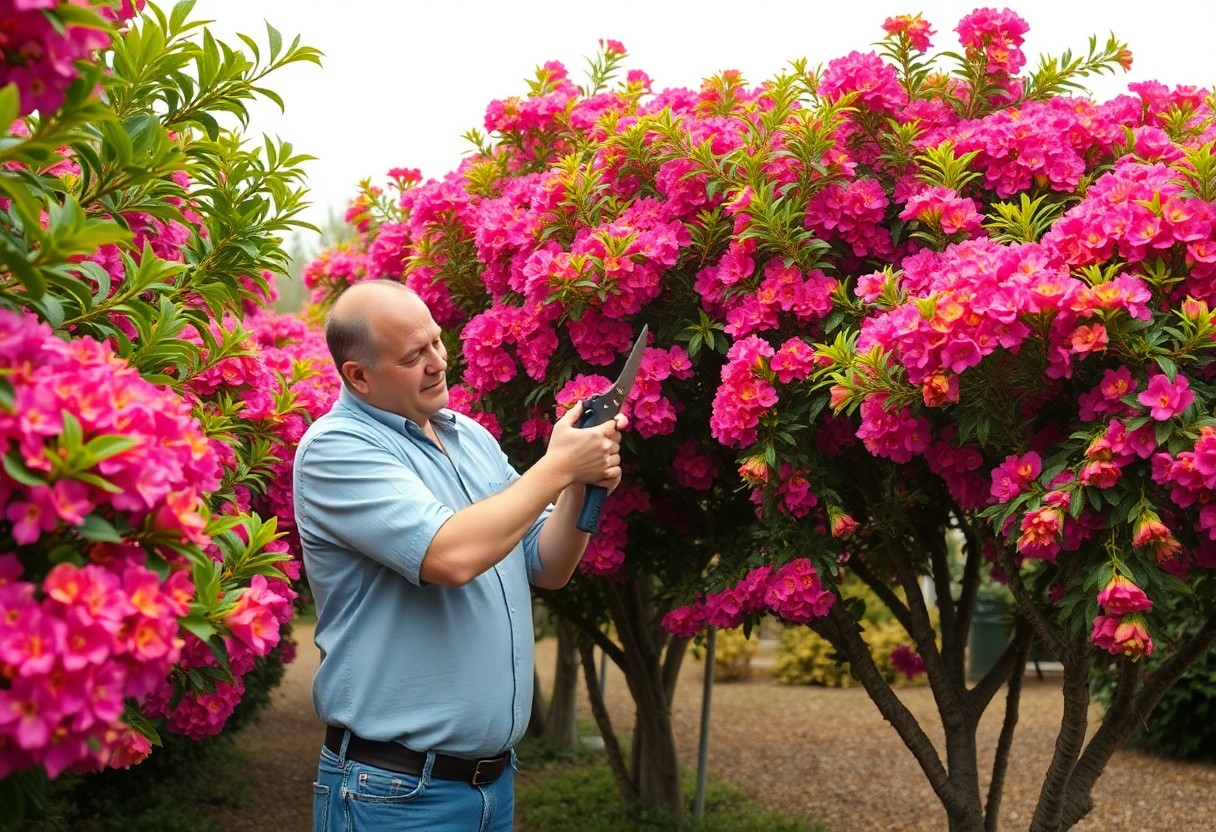
This guide will help you transform your crape myrtles into stunning focal points in your garden! Pruning these beautiful shrubs is important for promoting healthy growth, enhancing blooms, and maintaining an attractive shape. Whether you’re a seasoned gardener or just starting out, you’ll find simple steps to ensure your crape myrtles thrive. Grab your pruning shears and let’s get started on keeping your landscape vibrant and full of life!
Understanding Crape Myrtles
A variety of beautiful and versatile trees and shrubs, crape myrtles are beloved for their stunning summer blooms and striking fall foliage. You’ll find them in gardens and landscapes across the United States, especially in warmer climates. With proper care, they can add color and elegance to your outdoor space. In this section, we will examine the different types of crape myrtles and their unique characteristics, so you can choose the right one for your garden.
Types of Crape Myrtles
Crape myrtles come in several types, each with its unique charm. Below is a table that summarizes the most popular types:
| Type | Description |
| Natchez | White blooms, peeling bark, grows to 30 ft. |
| Muskogee | Lavender blooms, more heat tolerant, 20 ft. tall. |
| Lagerstroemia indica | Varied colors, low maintenance, shrub type. |
| Red Rocket | Bright red flowers, fast growth, 15-20 ft. |
| Basham’s Party Pink | Vibrant pink blooms, large shrub, 15-25 ft. |
- This variety of options allows you to choose one that best fits your garden’s needs and aesthetic.
Growth Habits and Characteristics
To effectively prune and care for your crape myrtles, it’s crucial to understand their growth habits and characteristics. Crape myrtles typically exhibit a bushy growth form, showcasing a round or upright habit. Their vibrant flowers bloom on new wood, meaning the previous year’s growth significantly influences their appearance.
Growth plays a major role in how crape myrtles develop. You can expect them to reach impressive heights, ranging from smaller, shrub-like varieties to majestic trees over 30 feet tall. They thrive in full sun and can adapt to different soil types if well-drained. This knowledge will help you make informed decisions regarding pruning and maintenance, ensuring your crape myrtles flourish in your landscape.
When to Prune Crape Myrtles
Any seasoned gardener will tell you that timing is key when it comes to pruning your crape myrtles. The best time to tackle this task is during late winter or early spring, just before new growth begins. Pruning at this time encourages vibrant blooms and helps your trees maintain a desirable shape while minimizing stress.
Best Time of Year
One of the most beneficial times to prune is while your crape myrtles are still dormant. This period, typically in late February to early March, allows you to easily see the tree’s structure without the distractions of foliage. Your timing sets the stage for lush growth and a beautiful display of flowers in the summer.
Timing Based on Climate
Crape myrtles thrive in warmer climates, so your pruning time may vary based on local weather conditions. As temperatures begin to warm, you might notice your trees waking up from their winter slumber. This hints that it’s time to prune, but the exact timing can depend on when your region typically experiences frost-free days.
When you live in a milder climate, pruning can be done a bit earlier, often as soon as the risk of hard frost is gone. However, if you’re in a cooler zone, it’s best to wait until late winter to ensure that your crape myrtles are fully dormant. Paying attention to your local seasonal patterns will help you achieve the best results for your beautiful trees.
Tools for Pruning
Even if you’re a beginner, using the right tools for pruning can make the process much more manageable. Quality tools not only make your work easier but also help ensure healthy growth for your crape myrtles. With a few vital tools in hand, you’ll be ready to tackle pruning like a pro.
Essential Pruning Tools
Tools like bypass pruners, loppers, and hand saws are vital for successfully pruning your crape myrtles. Bypass pruners are perfect for small branches, while loppers can handle thicker stems. A hand saw is great for larger limbs, ensuring your cuts are clean and precise. Investing in these tools will make your pruning tasks much simpler.
Safety Tips for Using Tools
If you want to stay safe while pruning, it’s vital to follow some basic safety guidelines. Always wear protective eyewear to shield your eyes from flying debris. Keep your tools sharp and well-maintained for better performance. Here are some additional safety tips:
- Wear gloves to protect your hands.
- Use a sturdy ladder for higher branches.
- Make sure your work area is clear and safe.
- Keep your hands away from the blades while cutting.
Any time you use tools, safety should be your top priority.
With the right mindset and precautions in place, you can enjoy a worry-free pruning experience. Always be aware of your surroundings, and ensure you’re standing on stable ground while you work. Here are more helpful tips:
- Communicate with anyone nearby about your actions.
- Secure loose clothing and long hair to avoid entanglement.
- Have a first aid kit handy in case of emergencies.
- Take breaks to avoid fatigue.
Any precaution you take will contribute to a safe and productive pruning session.
How to Prune Crape Myrtles
All you need is a bit of knowledge and the right tools to keep your crape myrtles healthy and beautiful. Pruning these lovely trees will promote better growth, improve flowering, and shape their overall appearance. Get ready to snip away those unwanted branches and watch your crape myrtles thrive!
Step-by-Step Pruning Guide
Step-by-Step, here’s a straightforward approach to pruning your crape myrtles:
| Step | Action |
| 1 | Gather tools: sharp pruners and loppers. |
| 2 | Remove any dead or diseased branches. |
| 3 | Thin out crowded areas for better air circulation. |
| 4 | Cut back to 1/4 inch above a bud to encourage growth. |
| 5 | Step back and evaluate your work, making adjustments if needed. |
Common Mistakes to Avoid
There’s a few common pitfalls to steer clear of when pruning your crape myrtles. Over-pruning can lead to excessive new growth and decrease flowering. Additionally, pruning at the wrong time can stress the trees, so timing is vital.
Pruning too aggressively not only disturbs your plant’s natural shape but can also lead to weak growth. Avoid cutting all the way back to the main trunk, which can cause unsightly regrowth. Be sure to prune during the right season, ideally late winter or early spring, to promote healthy blooms the following season. With a little care and attention, your crape myrtles will flourish beautifully!
Tips for Maintaining Healthy Crape Myrtles
For vibrant, lush crape myrtles, it’s imperative to focus on consistent care and monitoring. Here are some tips to keep your plants thriving:
- Water deeply, especially during dry spells.
- Remove spent blooms to encourage new growth.
- Check for pests regularly and treat promptly.
- Mulch to retain moisture and suppress weeds.
Any efforts you put into maintaining your crape myrtles will yield beautiful results!
Regular Care and Maintenance
Assuming you keep an eye on your crape myrtles, tasks like pruning and deadheading will become part of your routine. Regular observation will help you catch any signs of stress or disease early, enabling you to take corrective actions swiftly.
Fertilization and Watering Tips
You will find that proper fertilization and watering are imperative to the health of your crape myrtles. Here are some helpful practices to implement:
- Use a slow-release fertilizer in spring.
- Avoid overwatering, as this can lead to root rot.
- Water at the base to keep leaves dry.
- Run a garden hose to ensure deep watering once a week.
Perceiving how your crape myrtles respond to watering will guide you in adjusting your care routine.
Plus, understanding their specific needs can make a significant difference. Here are more tips to ensure your crape myrtles thrive:
- Opt for a balanced fertilizer to support blooming.
- Water early in the day to minimize evaporation.
- Monitor rainfall so you can adjust your watering schedule accordingly.
- In the heat of summer, consider a deep watering every other week.
Perceiving your plants’ preferences will foster a healthier, more vibrant garden.
Factors to Consider Before Pruning
Many factors come into play when deciding how and when to prune your crape myrtles. You’ll want to think about the following:
- The time of year
- Your plant’s age
- Weather conditions
- The desired shape and size
Any consideration can lead you to make the best decisions for your plant’s health and appearance.
Age and Health of Plant
Health is key when pruning your crape myrtle. If your plant is young and thriving, regular pruning can help shape it and promote vigorous growth. However, if it’s older or showing signs of distress, you might want to limit your pruning activities to avoid additional stress.
Desired Shape and Size
For effective pruning, knowing the desired shape and size of your crape myrtle is important. Each variety can be shaped differently to achieve a beautiful landscape aesthetic.
Desired shapes can be anything from a broad, rounded form to a more narrow, upright structure. By considering how you want your plant to look in your garden, you can make informed pruning decisions. Keep in mind that selective pruning can enhance flowering and overall growth, allowing you to enjoy a stunning display each season.
Conclusion
Following this guide will help you successfully prune your crape myrtles, enhancing their beauty and promoting healthy growth. By cutting back at the right time and using the proper techniques, you can encourage vibrant blooms and a well-shaped tree. Enjoy the process and take pride in your gardening skills, knowing that your efforts will result in stunning plants for you and your space.







